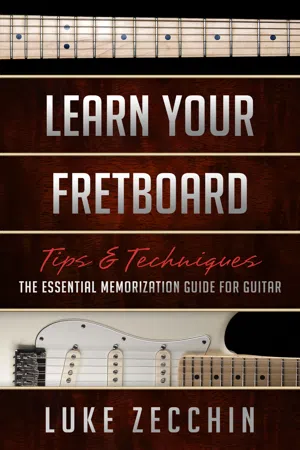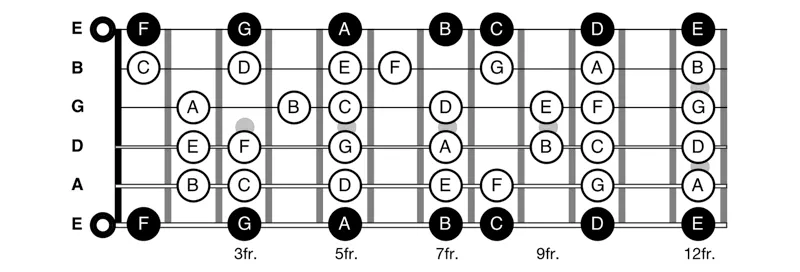

Learn Your Fretboard
The Essential Memorization Guide for Guitar (Book + Online Bonus Material)
- English
- ePUB (mobile friendly)
- Available on iOS & Android
Learn Your Fretboard
The Essential Memorization Guide for Guitar (Book + Online Bonus Material)
About This Book
FRETBOARD MEMORIZATION MADE EASY
Do you get lost on the guitar neck? Not knowing the notes on the fretboard is a common problem that slows down and confuses the learning process. It's very difficult to find your way around if you can't read the map! Fortunately, developing a working knowledge of the fretboard is among the simplest and most beneficial things a guitar player can do to streamline and accelerate their learning.
Learn Your Fretboard offers a fresh and straightforward approach to memorizing the guitar neck. This handbook outlines a definitive system for fretboard visualization that will inspire breakthroughs for guitar players of all skill levels. Regardless of whether you've tried and failed before, this is the perfect companion for any guitarist wanting to develop a command of the fretboard in real playing situations!
ONLINE BONUS: This book is complete with free online bonus material. It comes bundled with a companion website to enhance your learning experience. Extras include audio examples, backing tracks, bonus downloads, and more.
Join thousands of students worldwide! Like easy-to-follow lessons, pro playing tips, and jam-packed value? You'll love learning from this international bestselling instructor.
SCROLL UP AND BUY NOW TO GET STARTED
Frequently asked questions
Information
Chapter One
FRETBOARD BASICS

Refining Our Focus

- First, although we’re staring at over 130 different notes across the guitar fretboard, there’s actually a large amount of repetition here. Remember, the musical alphabet has only 12 notes, and these notes repeat in a consistent and predictable fashion.
- Second, even though a standard guitar usually has 22 or more frets, we can see that the 12th fret is a direct repetition of the open strings (just one octave higher in pitch). If we dissect the guitar neck at this point, we’re basically left with an identical mirror image between the bottom half and top half of the fretboard. This means learning the fretboard is only half as difficult as it first appears!

- First, if it’s not already clear, the high E string on the guitar is an exact replica of the low E string. Conveniently, we’re only really dealing with learning the notes across five different strings, not six. This means over 30% of the work in memorizing the fretboard is already done for us, just from learning the low E string!
- Second, the musical alphabet cycles in a consistent pattern across the fretboard. The seven natural notes move from A to G before looping back to A again. This sequence always occurs in a straightforward and predictable way. Each note simply moves up one whole step (two frets) from the last note. The only exceptions to this are between B to C and E to F. These notes are connected by just one half step (one fret).
One Fret or Two?

A Basic Checklist
- What notes occur across the open strings when a guitar is in standard tuning?
- Which two strings share an identical sequence of notes?
- Approximately how many frets are there on a normal guitar fretboard?
- At which fret do the no...
Table of contents
- Cover
- Title Page
- Copyright
- Dedication
- Fretboard Memorization Workshop
- Contents
- Preface
- Online Bonus Material
- Introduction
- 1. FRETBOARD BASICS
- Refining Our Focus
- One Fret or Two?
- A Basic Checklist
- Exercise 1
- Exercise 2
- 2. BUILDING A FRAMEWORK
- Location & Integration
- Vertical Anchor Points
- Fretboard Acronyms
- Exercise 3
- Exercise 4
- 3. MOVABLE OCTAVE SHAPES
- Fretboard Repetitions
- Moving Shapes
- Connecting the Dots
- Exercise 5
- Exercise 6
- 4. ADVANCED NAVIGATION
- Floating Reference Points
- Half-Step Note Groupings
- Whole-Step Note Groupings
- Exercise 7
- Exercise 8
- 5. VISUALIZATION & INTEGRATION
- Repetition Is Key
- Tips on Memorization
- Fretboard Worksheets
- Worksheet 1
- Worksheet 2
- Worksheet 3
- Worksheet 4
- Exercise 9
- Exercise 10
- Final Thoughts
- Liked This Book?
- Additional Resources
- About the Author
- Books by Luke Zecchin
- Special Offer